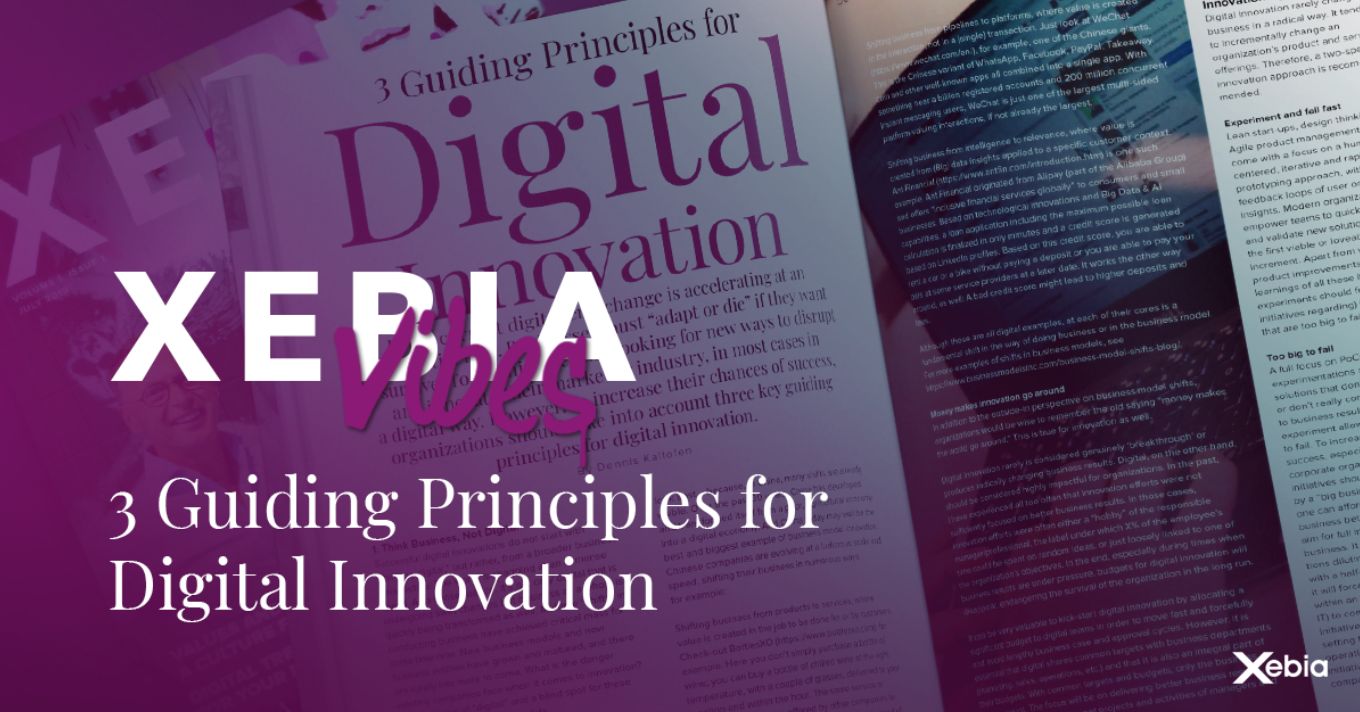In the current digital era, change is accelerating at an exponential rate. Businesses must “adapt or die” if they want to survive. To do this, they are looking for new ways to disrupt and innovate their market or industry, in most cases in a digital way. However, to increase their chances of success, organizations should take into account three key guiding principles for digital innovation.
- Think Business, Not Digital
Successful digital innovations do not start with “thinking digital,” but rather, from a broader business perspective. The world is changing at an immense speed. As a consequence, it’s not only digital that is undergoing swift changes but business as a whole is quickly being transformed as well. Multiple “shifts” in conducting business have achieved critical mass for some time now. New business models and new business entities have grown and matured, and there are surely lots more to come. What is the danger existing companies face when it comes to innovation? A limited view of “digital” and a blind spot for these shifts in current business models.
Start with outside-in business model innovation
Changing a single element of a business model can already result in a serious shift and disruption or innovation in the way of doing business. Nowadays, organizations shouldn’t look to the West for inspiration regarding these business model shifts. They should look East – because, in China, many shifts are already visible. Over the past 30 years, China has developed and transformed itself from a poor, agricultural economy into a digital economy. And China today may well be the best and biggest example of business model innovation. Chinese companies are evolving at a ludicrous scale and speed, shifting their business in numerous ways, for example:
-
Shifting business from products to services, where value is created in the job to be done for or by customers. Check-out BottlesXO (bottlesxo.com), for example. Here you don’t simply purchase a bottle of wine; you can buy a bottle of chilled wine at the right temperature, with a couple of glasses, delivered to your location and within the hour. The same service or convenience is being offered by other companies for goods/services such as coffee at the office. Instead of walking to a coffee machine and pushing a button, just tap a few buttons on a mobile app to order a fresh hot Caffè Latte delivered to your desk. Uber meets coffee.
- Shifting business from pipelines to platforms, where value is created in the interaction, not in a (single) transaction. Just look at WeChat (wechat.com), for example, one of the Chinese giants. This is the Chinese variant of WhatsApp, Facebook, PayPal, Takeaway.com and other well-known apps all combined into a single app. With something near a billion registered accounts and 200 million concurrent instant messaging users, WeChat is just one of the largest multi-sided platform-valuing interactions, if not already the largest.
- Shifting business from intelligence to relevance, where value is created from (Big) data insights applied to a specific customer context. Ant finanacial is one such example. Ant Financial originated from Alipay (part of the Alibaba Group) and offers “inclusive financial services globally” to consumers and small businesses. Based on technological innovations and Big Data & AI capabilities, a loan application including the maximum possible loan calculation is finalized in only minutes and a credit score is generated based on LinkedIn profiles. Based on this credit score, you are able to rent a car or a bike without paying a deposit or you are able to pay your bills at some service providers at a later date. It works the other way around, as well: A bad credit score might lead to higher deposits and fees.
Although these are all digital examples, at each of their cores is a fundamental shift in the way of doing business or in the business model. For more examples of shifts in business models, see business model shifts blog.
Money makes innovation go around
In addition to the outside-in perspective on business model shifts, organizations would be wise to remember the old saying “money makes the world go around.” This is true for innovation as well.
Digital innovation rarely is considered genuinely ‘breakthrough” or produces radically changing business results. Digital, on the other hand, should be considered highly impactful for organizations. In the past, I have experienced all too often that innovation efforts were not sufficiently focused on better business results. In those cases, innovation efforts were often either a “hobby” of the responsible manager/professional, the label under which X% of the employee’s time could be spent on random ideas, or just loosely linked to one of the organization’s objectives. In the end, especially during times when business results are under pressure, budgets for digital innovation will disappear, endangering the survival of the organization in the long run.
It can be very valuable to kick-start digital innovation by allocating a significant budget to digital teams in order to move fast and forcefully and avoid lengthy business case and approval cycles. However, it is essential that digital shares common targets with business departments (marketing, sales, operations, etc.) and that it is also an integral part of their budgets. With common targets and budgets, only the business results count. The focus will be on delivering better business results, instead of possibly funding pet projects and activities of managers and professionals.
- Use a Two-Speed Innovation Approach
Digital innovation rarely changes business in a radical way. It tends to incrementally change an organization’s product and service offerings. Therefore, a two-speed innovation approach is recommended.
Experiment and fail fast
Lean start-ups, design thinking, Agile product management – all come with a focus on a human-centered, iterative and rapid prototyping approach, with fast feedback loops of user or customer insights. Modern organizations empower teams to quickly identify and validate new solutions and build the first viable or loveable product increment. Apart from valuable product improvements, the learnings of all these iterations and experiments should fuel (enabling initiatives regarding) innovations that are too big to fail.
Too big to fail
A full focus on PoCs, pilots, and experimentations may result in solutions that don’t scale enough or don’t really contribute enough to business results. After all, an experiment allows the opportunity to fail. To increase the chances of success, especially in larger corporate organizations, “fail fast” initiatives should be accompanied by a “big business launch” that no one can afford to fail. This big business bet will avoid isolation and aim for full integration within the business. It will prevent organizations diluting resources or ending up with a half-baked solution because it will force different departments within an organization (sales, digital, IT) to combine forces, tightly align initiatives, and collaborate on setting targets, governance, and operating models. ‘Too big to fail’ initiatives have a slower speed compared to ‘fail fast experiments’. However, the result might be a more radical innovation. Combined, a two-speed innovation approach might deliver significantly more business value.
- Design Transformations, Not Tactics
Executing a two-speed innovation approach that is fully integrated within the business is no longer a tactical innovation effort or project – it is a transformational one. And transformations need a balanced, holistic approach.
In our digital transformation practice, we always start with a focus on business value - where to play, how to win, how to create new competitive advantage, and how to make money. Realizing business value, however, requires two enabling dimensions: organization (people, process, structure) and IT & Data infrastructures. Your readiness for success is determined by your current business practices in combination with a balanced portfolio of additional initiatives in each of these domains. If future objectives are not well-balanced, they will not be (fully) realized. Three phases of organizational change outline different approaches:
Tactical: Individual practices and initiatives are in place, but there is no coherent plan encompassing all of them with a strategy for building out to the future. The wins might be quick in every individual domain, but there is no provision for scale.
Strategic: A broader vision governs individual practices and initiatives, which are designed and developed with an eye to future needs and scale. The organization starts to embrace change, streamlining operational processes, so teams become both efficient and effective, increasing the value of innovation to the business.
Transformational: Practices and initiatives are focused on constant adaptation to future change. People and processes are being transformed, which further supports the technological changes so that data and insights are continuously integrated into new innovations and service offerings in order to stay relevant and create value.
The tactical phase focuses on reducing costs with a quick return on investment and little disruption to your organization - a short-term goal. In the strategic phase, the focus is on increasing the value delivered by your organization by streamlining operations to be both more efficient and more effective, and it is a mid-term goal. The transformational phase focuses on the long-term goal of becoming an engine of innovation and being able to adapt to change continuously in order to create sustainable value.
Conclusion
Nowadays, organizations must accelerate their innovation efforts if they want to survive in the “adapt or die” business climate. In order to increase their chances of success, organizations should take into account three key guiding principles for digital innovation:
- Think Business, Not Digital. Start with an outside-in business model innovation. At the same time, keep in mind that money makes the world go around, so align your targets and budget with other important (commercial and operational) departments within your organization.
- Use a Two-Speed Innovation Approach. Balance experiments and pilots with building capabilities for big business propositions that no one can afford to fail. Learn and fail fast while structurally enabling your organization for the (ever-changing) future.
Design Transformations, Not Tactics. Ensure integrated organizational practices, where business value (for the customer as well as for the organization) is the starting point, enabled by adaptable organizational and IT and data infrastructure.





